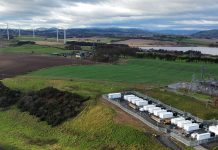 National Grid expects embedded solar PV to increase by 150MW a month over 2017, which would take UK installed capacity towards 13.5GW. Meanwhile the system operator has spelt out the scale of the challenge it now faces in keeping the system balanced in summer as well as winter.
National Grid expects embedded solar PV to increase by 150MW a month over 2017, which would take UK installed capacity towards 13.5GW. Meanwhile the system operator has spelt out the scale of the challenge it now faces in keeping the system balanced in summer as well as winter.
National Grid’s Summer Outlook report says summer minimum demand continues to fall as generators connected to the distribution system, over which it has limited visibility, continue to rise.
Summertime rolls
National Grid will therefore pay other generators to stop pushing power onto the transmission system over summer. It must do that to keep frequency stable at 50Hz. Too much power drives frequency upwards, too little creates a drop in frequency. Once it hits a pre-set threshold, actions are taken to keep it in check. Otherwise the system could potentially fail, leading to power cuts.
Dynamic frequency response is one way of keeping the system balanced. Automated fast-acting assets, such as batteries or fridges or electro furnaces, can be aggregated to respond in either direction. National Grid has other forms of frequency response at its disposal but may decide to wrap them all into a single ‘pre-fault’ service in order to maximise fast types of frequency response when trigger points are reached.
Get your RoCoF
However, National Grid has also recognised the need to deal more proactively with system inertia issues. Along with generators, technology firms and aggregators, it is involved in trials of technology that would enable it to react not just at set trigger points, but to the speed of frequency change. Those trials, around rate of change of frequency (RoCoF) should also give National Grid a clearer understanding of how regional variances can lead to different knock-on effects throughout the system.
Turn up, tune in, drop off
This summer, National Grid is likely to procure most demand turn up (DTU) during June and July, when it predicts demand will be lowest due to long daylight hours increasing solar generation.
Demand turn up pays companies to increase power consumption or turn off their on-site generation and instead draw power from the grid, helping to reduce system frequency.
While National Grid has already procured 138.6MW of DTU via a fixed tender in February, it will likely buy several times more capacity via flexible tenders run fortnightly during spring and summer. Providers in the flexible tenders can name their own price. If it is cheaper for National Grid to take that price than to use other balancing options, those companies are called upon to deliver.
Given solar was creating challenges for the system operator as early as March this year, it looks set to be an interesting service in terms of how providers play their hands within ongoing tenders.
National Grid confirmed late last year that it would look to broadly double the 300MW of DTU it procured in 2016.
See the full summer outlook here.
Developments within demand turn up and frequency response will be covered at The Energyst’s DSR Event in London, 7 September. Register for a ticket here.
Related articles:
As solar generation makes history, National Grid starts to feel the burn
National Grid procures 138.6MW of demand turn up to balance solar in summer
National Grid to extend demand turn-up running hours, procure more
Greg Clark calls for carmakers and energy firms to deliver battery storage
National Grid mulls rolling all frequency balancing services into one scheme
National Grid says impact of solar requires greater system flexibility
Battery storage: Positive outlook or does a correction loom?
Open Energi and Camborne Energy Storage take Tesla battery into frequency response market
Scottish Power asks Ofgem to change classification of batteries in capacity market
Centrica: Floodgates to open on battery storage this summer
UK Power Networks receives 12GW of battery storage applications in 15 months
National Grid boss: future of energy is demand not supply
National Grid says impact of solar requires greater system flexibility
Restore signs 25MW demand turn up deal with National Grid
Flexitricity launches demand turn up service
Demand turn-up: What worked, what didn’t?
Western Power Distribution ramps up demand-response trials, calls for participants
Smart grids ‘require local control and businesses must play or pay’
More than half of I&C firms mulling energy storage investment
National Grid says UK will miss 2020 targets, predicts big battery future
Free demand-side response report
Follow us at @EnergystMedia. For regular bulletins, sign up for the free newsletter.



